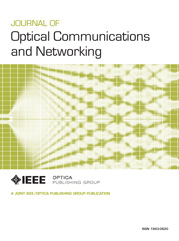Special Issue on Advances in Multi-Band Optical Networks
Submissions Open: 1 September 2022
Submission Deadline: 1 April 2023
Recent reports show that mobile traffic currently accounts for approximately 9% of the total IP traffic generated by the Internet. The upcoming massive deployment of 5G/IoT devices and services are expected to double the global mobile IP traffic with respect to the fixed one, reaching more than 20% of total IP traffic during this year 2022. Such a tremendous increase of connected devices and traffic is expected to push optical network capacity beyond its current limit.
A possible solution to increment the capacity of the optical layer is by deploying integrated packet-optical transport architecture based on multi-band (MB) optical transmission and switching networks. Then, MB optical systems represent the next technological evolution to deal with the traffic demand and service requirements of 5G mobile networks, and beyond, in the most cost-effective manner. MB expands the available capacity of optical fibers, by enabling transmission within S, E, and O bands, in addition to commercially available C and/or C+L bands. The total bandwidth will be around 53 THz, which translates into a potential 10x transmission capacity increase with respect to C-band only.
To realize MB networks, however, technology advances are required, both in the data and the control and management planes. The devices needed for MB data plane include new optical amplifiers, filter-less sub-systems, add/drop multiplexers, reconfigurable optical add-drop multiplexers (ROADM), and transmission systems.
These technology advances complement novel packet-optical white boxes using flexible MB sliceable bandwidth/bit rate variable transceivers (BVTs) and novel pluggable optics (e.g., of type point-to-multi-point – P2MP, ZR/ZR+). The availability of MB transmission will also lead to a complete redesign of the end-to-end architecture, removing boundaries between network domains, reducing electronic intermediate terminations, and providing a network continuum between X-haul/access, aggregation, metro, and core segments. This will help define cost-effective solutions to support massive small cell deployments.
The control plane needs to be significantly extended to support MB elements and a ‘domain-less' network architecture, where coordination and cooperation of MB elements will be needed to enable seamless software-defined networking (SDN) service orchestration and provisioning. The control plane needs to extensively rely on physical layer abstraction, new MB impairment modelling, and pervasive telemetry data collection to feed artificial intelligence (AI) / machine learning (ML) algorithms leading to a zero-touch networking (ZTN) paradigm for MB networks. Ultimately, this could result into a new, open network operating system (NOS) deployed at the packet-optical white box.
The scope of the special issue includes but is not limited to the following topics:
- Vendors' and operators' view on the deployment of MB optical transmission;
- Evaluation of high-capacity optical transmission solutions, including MB, and how they could integrate with the IP layer;
- Optical support for B5G/6G front-haul mid-haul and cost analysis, including energy consumption;
- Experiments related to optical transmission in the S, E, and O bands, together with commercially available C+L bands;
- Novel optical MB transmission and switching schemes and architectures, e.g., novel applications of sliceable BVTs and pluggable optics, including P2MP connectivity;
- Centralized vs. distributed vs. hierarchical architectures for control and telemetry;
- Zero-touch networking (ZTN) and machine-learning based applications for MB optical networks;
- Monitoring and telemetry in multi-layer / multi-domain / multi-band / multi-technology networks open/disaggregated optical systems;
- Digital twins modeling the optical layer and their application for planning, control and orchestration;
- Near real-time control of optical MB network resources.
Submissions to the special issue should be prepared according to the usual standards for the Journal of Optical Communications and Networking and will undergo the normal peer review process. Manuscripts must be uploaded through the online submission system specifying from the Feature Issue drop-down menu that the manuscript is for the issue on Advances in Multi-Band Optical Networks.
Guest Editors
Luis Velasco, Universitat Politècnica de Catalunya (UPC), Spain (Lead Guest Editor)
Filippo Cugini, Consorzio Nazionale Interuniversitario per le Telecomunicazioni (CNIT), Italy
Ramon Casellas, Centre Tecnològic de Telecomunicacions de Catalunya (CTTC), Spain
Masahiro Nakagawa, NTT, Japan
Glenn Wellbrock, Verizon Communications, USA
Xiaoliang Chen, Sun Yat-Sen University, China

